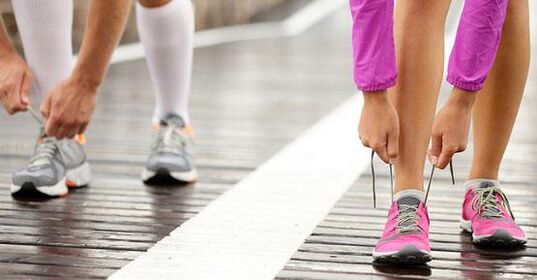
Everyone knows that running can help you lose weight. But hardly anyone is aware that there is a suitable jogging for weight loss. After reading this article, the reasons for the lack of the desired results in many people who have chosen this type of enhancement of their figure will become clear.
The benefits of running
By starting to jog, you will be doing your body an invaluable service, filling it with health and strength:
- The blood will be saturated with oxygen;
- The heart and the entire vascular system will be strengthened;
- The bones will become stronger;
- The lungs will increase the vital volume.
During the race, breathing and heart rate become more frequent, thereby speeding up metabolic processes and burning excess fat. But you can only lose weight by doing it right.
An important point :running for 15-20 minutes will not make your figure slimmer, although the healing effect will be obvious.
It is recommended to start running two to three times a week, gradually reaching daily workouts with two days of rest.
And don't use weighting equipment, especially for beginners. Such devices are mainly used by athletes to strengthen leg muscles and increase speed during competition.
So how do you need to run properly to improve your fitness.

Types of jogging for weight loss
To better understand the effectiveness of a particular type of running, you need to understand the mechanism of the work of the body during different loads:
- Light jogging forces the muscles to draw energy from the sugar (glycogen) stored in the liver. It is usually consumed within 40 minutes of such a charge. After eating breakfast after training, you cannot lose weight because the lost sugar will come back.
- Running for more than an hour causes the body to break down fat. Externally, this is determined by heavy breathing and fatigue.
- If you run for more than an hour and a half, energy starts to replenish from protein, reducing muscle mass.
- When alternating fast running with light running and walking, a powerful process of fat breakdown begins.
At the same time, there is a certain pattern: a person with a larger body mass burns more calories.
It follows that you need to jog to lose weight for an hour, but not more than 1 hour 15 minutes or at regular intervals.
About interval running
This type is more suitable for busy people who do not have the opportunity to devote an hour to training. It consists of alternating fast running and recovery walking. With such a load, certain processes in the body are triggered, resulting in the burning of fat stores.
It only takes half an hour to do it. The program consists of 4 stages:
- The first 100-meter walk is done at a brisk pace, which helps the body prepare for the load.
- For the next 100 meters, do a light run, adjusting your breathing.
- Then you have to travel the same distance at maximum speed.
- And again, jog, restoring breathing.
Repeat all steps for 30 minutes.
Important:At the end of the training in the next 6 hours, the human body continues to lose extra pounds.
About the easy run (jogging)
A recommendation for beginners is not to run high speed marathons right away. The best way to start your training is to walk slowly with a gradual transition to running. While walking, you can do lunges, squats, and jumps. Certain techniques must be followed:
- Breathe evenly and carefully, inhaling through your nose and exhaling through your mouth;
- Keep your back straight with a forward gaze;
- The knees are slightly bent, which will reduce stress on the joints;
- The arms are bent at the elbows and move along the body.
A word of advice for women: on "critical days" if you feel bad, don't overexert yourself. Two days off won't hurt.

About food
As for nutrition during the race, this is also a fairly important topic. The goal is to keep energy at the right level and prevent the toxic effect of lactic acid with ketones.
Since we see running as a way to lose weight, it is permissible to eat before training no later than an hour and a half.
Before training
At the same time, you should not rely on grains and legumes, potatoes and eggplants, mushrooms and cabbage, as well as spinach with radishes. Do not eat fatty and fried foods.
To relieve the kidneys, blood vessels and heart from an excessive load, fluid intake should also be limited. The maximum recommended dose is a glass of water or sweet tea half an hour before jogging. But while running, you need to drink in sips - 2-3 every 2 km.
After running
At the end of the workout, you need to replenish the depleted carbohydrates with a glass of tomato, apple, grape or citrus juice.
After about 20-40 minutes (the time is individual, but neither sooner nor later), you can eat without overeating and without relying on heavy food.
Best time to run
And, of course, one cannot fail to say when is the best time to train in order to lose weight. To make the right choice, you need to know the following:
- In the morning, the human body lacks carbohydrates, which requires energy to train from body fat. In this case, you need to run on an empty stomach.
- Running at night will help burn the energy accumulated during the day, melting fat. This is especially true for office workers who are forced to sit in front of the computer all the time. To lose weight, it is best to run after a light dinner after at least an hour. And before going to bed, drink low-fat kefir or eat an apple.
As you can see, you can run for weight loss anytime that's convenient for you - the bottom line is knowing.

Who shouldn't run
It is not recommended to start running for people with health problems such as:
- High blood pressure (hypertension);
- Heart disease and coronary artery disease;
- Deformed vertebrae;
- Stomach ulcer and varicose veins;
- Myopia;
- Diseases of the endocrine system and bronchial asthma.
In addition, you can not train for diseases at the stage of exacerbation and in inflammatory processes. Surgery or recent injuries are also contraindications to running.
Armed with all of this knowledge, you can safely do this fascinating type of physical education. The process will be even more enjoyable if you call a friend or friend for a run.














































































